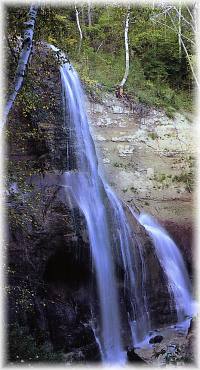Smith Falls State Park, NE
Although, many Nebraskans continue to look to other states for scenic wonders, increasingly they are finding them close to home. Many of the state's most picturesque spots are on private land, though, and remain as inaccessible as they were in Barbour's day. Smith Falls, 15 miles east of Valentine, is such a scenic natural wonder. Created where a small, spring-fed creek tumbles about 70 feet over a rock ledge to the Niobrara Valley below, it is Nebraska's highest waterfall. During the last two decades, canoeists have discovered the Niobrara River and Smith Falls, but Nebraska's highest waterfall remained largely unseen by the general public until 1996 when an old historic bridge was refurbished and placed across the river allowing foot access to the falls. Before, access was only by canoe or an old hand powered cable car. Surprisingly, only one other of the state's waterfalls is found on public land, the nearby Fort Falls on the Fort Niobrara Wildlife Refuge.
A Remnant of Ice Age Nebraska
Smith Falls is more than just a touris attraction, it is a naturally occurring biological museum. As the last glacier retreated north some 12,000 years ago, Nebraska's climate turned warmer and drier. Spruce and birch forest, which once covered the state, could not survive in this new climate and was replaced by prairie, except in the cool, wet canyons which feed into the Niobrara River east of Valentine. In these spring-branch canyons, remnants of the Ice Age fauna and flora persist. Protected from desiccating summer winds in the north-facing canyons, paper birch communities with an understory of northern grasses, sedges and forbs still thrive, 200 to 400 miles south of their modern-day range. At the foot of Smith Falls is a colony of unique trees, a hybrid of quaking aspen, a northern species, and big-toothed aspen, an eastern species.
A Scenic River
Because of the Niobrara's striking scenery, recreational use and biological significance, a 70 mile segment of the river east of Valentine was designated a National Scenic River in May 1991. At the same time, a 25-mile stretch of the Niobrara, from the western border of Knox County to the Missouri River, was designated a Federal Recreational River. In a statement shortly after signing the scenic river bill, President George Bush called the Niobrara "an outstanding river resource."
